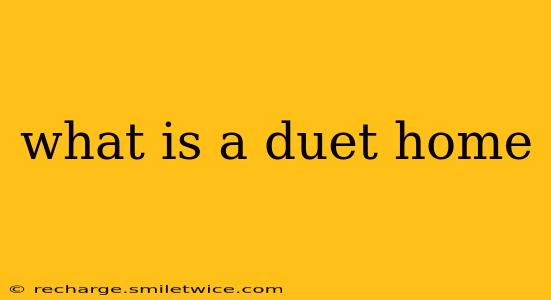A duet home, also sometimes referred to as a "paired home" or "duplex home," isn't a standardized architectural style but rather a concept describing a property where two separate living units share a common wall or structure. This shared element can manifest in various ways, leading to diverse designs and levels of interaction between the residents. Understanding the nuances of a duet home requires examining its key features and comparing it to similar dwelling types.
What are the Key Features of a Duet Home?
The defining characteristic of a duet home is the presence of two distinct living spaces within a single building. Each unit typically includes its own private entrance, kitchen, bathrooms, and bedrooms, ensuring complete independence for each household. However, the degree of shared space or proximity varies significantly. Some duet homes might share only a common wall, while others might include shared amenities like a laundry room or a small courtyard. The exterior might appear as two separate houses or as a single, larger structure with two distinct entrances.
How Does a Duet Home Differ from a Duplex?
While often used interchangeably, duet homes and duplexes have subtle differences. A duplex usually refers to a two-unit building where each unit is a mirror image of the other, often rented out separately by a single landlord. Duet homes, on the other hand, while sharing the two-unit structure, emphasize the independence and privacy of each home, sometimes even featuring distinct architectural styles for each unit. The focus is less on rental income and more on providing separate yet connected living spaces.
What are the Pros and Cons of Living in a Duet Home?
Pros:
- Shared Amenities (Potentially): Depending on the design, duet homes might include shared features, reducing individual maintenance costs and fostering a sense of community.
- Increased Privacy: While sharing a wall, duet homes provide significantly more privacy than apartments or townhouses. Each unit is a stand-alone residence.
- Cost-Effectiveness: Building costs might be lower due to shared structural elements. Maintenance and utility costs can also be shared (though not always the case).
- Sense of Community: The close proximity can foster a friendly neighborhood feel, allowing for easy interaction with neighbors if desired.
Cons:
- Less Yard Space: Depending on the design, duet homes may have smaller individual yards than standalone houses.
- Noise Concerns: Proximity to a neighboring household can mean more noise issues than living in a detached house.
- Shared Walls: Sounds can transfer through shared walls, which is a significant concern for some.
- Aesthetic Limitations: Shared architectural elements may limit customization options compared to standalone houses.
What are the different types of Duet Homes?
Duet homes can vary significantly in their design and features. Some might be more modern, focusing on minimalist aesthetics, while others adopt traditional architectural styles. The specific layout and amenities are dependent on the builder or homeowner's preferences and the available land. They can range from smaller, compact units to larger, more luxurious designs.
Is a Duet Home Right for Me?
The suitability of a duet home depends on your lifestyle and priorities. If you value privacy but also appreciate the potential for a close-knit community, a duet home could be an ideal choice. However, if noise is a significant concern or you require extensive outdoor space, a standalone house might be more suitable. Carefully weighing the pros and cons, along with a detailed examination of specific designs and locations, will aid in making an informed decision.
